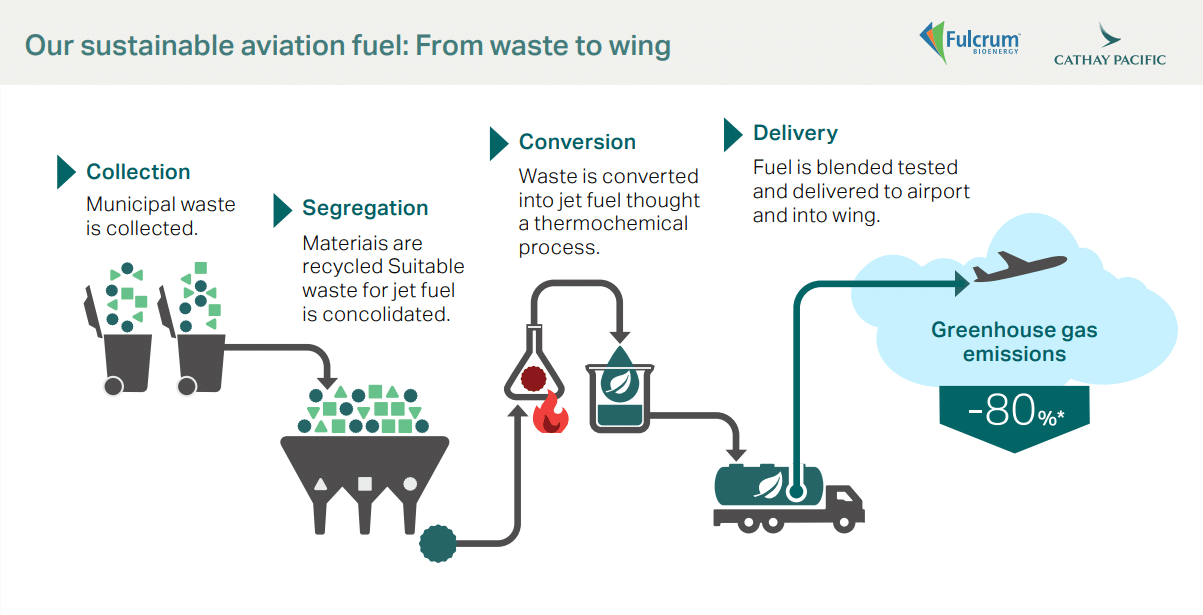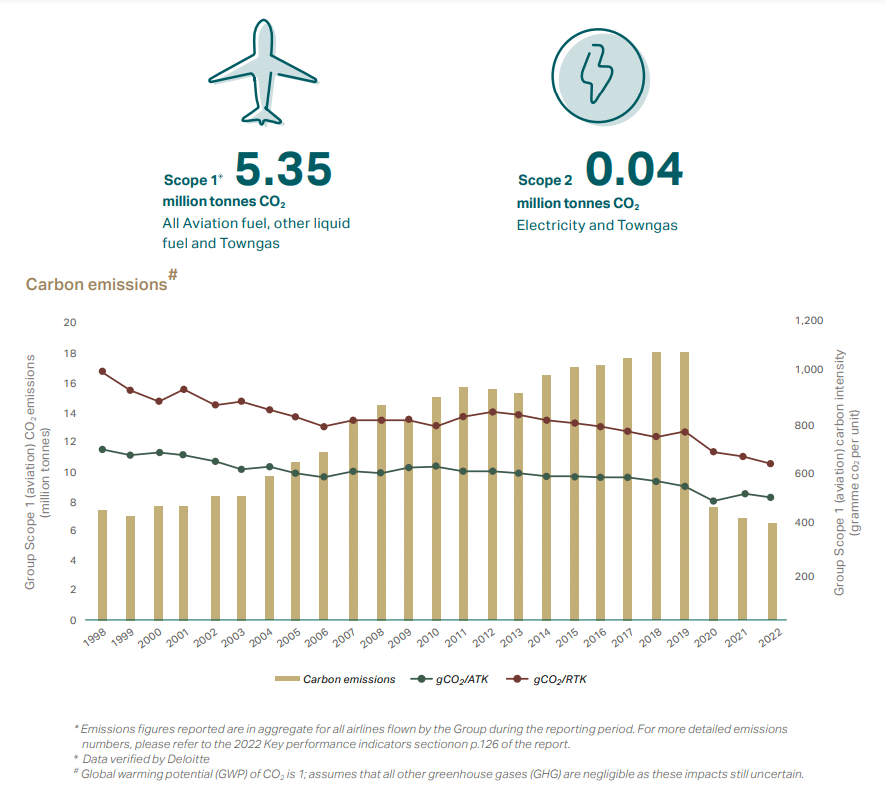Cathay Pacific has reaffirmed its commitment to environmental sustainability by setting a new target to reduce carbon intensity by 12% from the 2019 level by 2030. This ambitious goal aligns with the airline’s ultimate climate goal of achieving net zero carbon emissions by 2050.
What is Sustainable Aviation Fuel?
Central to achieving this target is the accelerated adoption of Sustainable Aviation Fuel (SAF). Cathay aims to scale up SAF usage across all aspects of its operations, including employee duty travel.
SAF is a clean alternative to fossil jet fuel that is produced from sustainable and renewable sources. These include agricultural residue, waste oils, municipal solid waste, industrial waste gases, or other non-fossil carbon sources.
This cleaner fuel has the potential to reduce lifecycle carbon emissions by over 80% based on the total carbon output created from every stage of production, distribution and usage. Starting from 2024, Cathay will use SAF to offset 10% of the carbon emissions from employee duty travel on its flights. This initiative builds upon Cathay’s existing efforts, such as its voluntary carbon offset program, Fly Greener, which has been offsetting all emissions from employee duty travel since 2007.
Carbon offsets represent a certain amount of compensated carbon emissions generated from the flights. Each offset, also known as carbon credit, is equivalent to a tonne of carbon emissions.
Since 2007, Cathay has been offsetting all emissions from employee duty travel on flights with the airline using carbon credits through Fly Greener. This initiative is in line with its pioneering position in accelerating the development and deployment of SAF in the region. And more importantly, contributing to its broader goal of reaching 10% SAF usage by 2030.
The airline is using SAF via the following process:


Through SAF, Cathay aims to play a significant role in accelerating the development and deployment of sustainable aviation solutions in the region while thriving to achieve its net zero targets.
Cathay Pacific’s Flight to Net Zero
Cathay Group generated over 5 million tonnes of CO2 in 2022, down 11% from 2021, per its latest Sustainability Report.
The new target focuses on improving carbon intensity by reducing carbon emissions from Cathay’s jet fuel use per revenue tonne kilometer (RTK) from 761 gCO2/RTK to 670 gCO2/RTK. To achieve this, Cathay plans to introduce more than 70 new passenger and freighter aircraft. These units are expected to be up to 25% more fuel-efficient compared to previous generations.
As seen in the chart below, Cathay was able to drive down its emissions since the onset of the COVID-19 pandemic. The trend continues for three consecutive years and the airline plans to further cutting down emissions.

 Cathay Pacific is one of the first Asian airlines to commit to achieving net zero carbon emissions by 2050. The company is using various means to get there, including:
Cathay Pacific is one of the first Asian airlines to commit to achieving net zero carbon emissions by 2050. The company is using various means to get there, including:
- With the use of Sustainable Aviation Fuel,
- Investing in new technology and fuel-efficient aircraft, and
- Using carbon offsets.
Investing in Sustainable Aviation Fuel:
Cathay Pacific is actively increasing its use of SAF to make it a mainstream option in aviation. As a pioneer in this area, Cathay Pacific became the first airline investor in Fulcrum BioEnergy in 2014. This partnership aims to convert household waste into SAF. The Group has committed to purchasing 1.1 million tonnes of SAF over the next decade, covering around 2% of its total fuel requirements starting from 2023.
Emissions Reduction through Efficiency Enhancements:
This includes transitioning to a new fleet of fuel-efficient aircraft and implementing practices to minimize engine use on the ground. Moreover, the Group commits to reducing ground emissions by 32% from the 2018 baseline by the end of 2030.
Offsetting Carbon Emissions:
Through its carbon offset program, Fly Greener, Cathay Pacific provides passengers with the opportunity to offset the CO2 emissions generated by their flights. Contributions made through this program directly support Gold Standard-accredited third-party projects focused on actively reducing emissions. Since its inception in 2007, the program has offset over 300,000 tonnes of carbon emissions.
Cathay’s Sky-High Commitment to Climate Action
Cathay Pacific’s CEO Ronald Lam emphasized the airline’s commitment to further enhancing its climate performance, saying that:
“…we are determined to improve our climate performance even further via accelerating the use of sustainable aviation fuel (SAF), modernising our fleet and driving operational improvements. This new carbon intensity target will provide necessary drive for actions in the immediate future towards achieving our long-term goals.”
As one of the pioneers in Asia to set a target of 10% SAF for its total fuel consumption by 2030, Cathay Pacific acknowledges the challenges involved in transitioning to more sustainable energy sources in aviation.
The airline has taken proactive steps to forge strategic partnerships with like-minded organizations and stakeholders across the SAF value chain. This includes initiatives such as Asia’s first major Corporate SAF Programme, enabling corporate customers to leverage SAF to reduce their aviation-related emissions.
Cathay also played a key role in establishing the Hong Kong Sustainable Aviation Fuel Coalition earlier this year.
Cathay Pacific’s ambitious commitment to reducing emissions is crucial for its ultimate goal of achieving net zero by 2050. With strategic partnerships and a dedication to operational improvements, Cathay is setting a high standard for the industry.
- SEO Powered Content & PR Distribution. Get Amplified Today.
- PlatoData.Network Vertical Generative Ai. Empower Yourself. Access Here.
- PlatoAiStream. Web3 Intelligence. Knowledge Amplified. Access Here.
- PlatoESG. Carbon, CleanTech, Energy, Environment, Solar, Waste Management. Access Here.
- PlatoHealth. Biotech and Clinical Trials Intelligence. Access Here.
- Source: https://carboncredits.com/cathay-pacifics-net-zero-flight-plan-12-reduction-target-by-2030/



